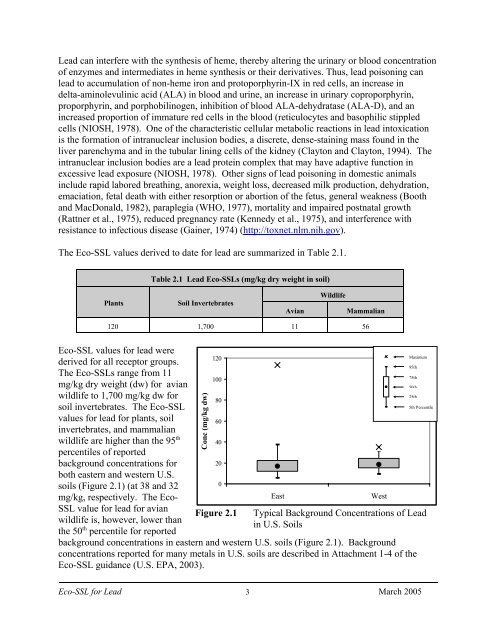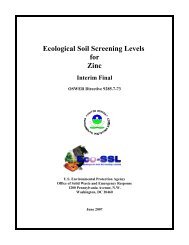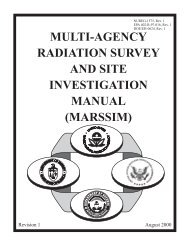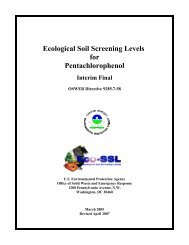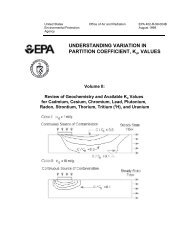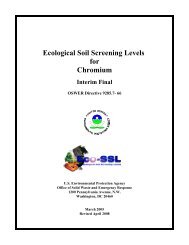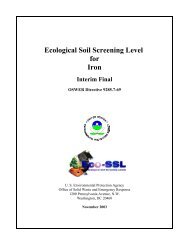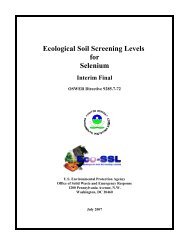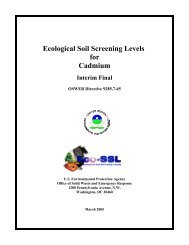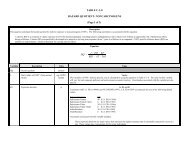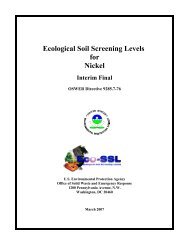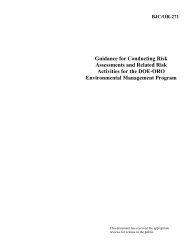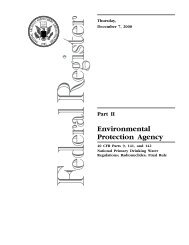C:\Eco-SSLs\Contaminant Specific Documents\Lead\November ...
C:\Eco-SSLs\Contaminant Specific Documents\Lead\November ...
C:\Eco-SSLs\Contaminant Specific Documents\Lead\November ...
You also want an ePaper? Increase the reach of your titles
YUMPU automatically turns print PDFs into web optimized ePapers that Google loves.
Lead can interfere with the synthesis of heme, thereby altering the urinary or blood concentration<br />
of enzymes and intermediates in heme synthesis or their derivatives. Thus, lead poisoning can<br />
lead to accumulation of non-heme iron and protoporphyrin-IX in red cells, an increase in<br />
delta-aminolevulinic acid (ALA) in blood and urine, an increase in urinary coproporphyrin,<br />
proporphyrin, and porphobilinogen, inhibition of blood ALA-dehydratase (ALA-D), and an<br />
increased proportion of immature red cells in the blood (reticulocytes and basophilic stippled<br />
cells (NIOSH, 1978). One of the characteristic cellular metabolic reactions in lead intoxication<br />
is the formation of intranuclear inclusion bodies, a discrete, dense-staining mass found in the<br />
liver parenchyma and in the tubular lining cells of the kidney (Clayton and Clayton, 1994). The<br />
intranuclear inclusion bodies are a lead protein complex that may have adaptive function in<br />
excessive lead exposure (NIOSH, 1978). Other signs of lead poisoning in domestic animals<br />
include rapid labored breathing, anorexia, weight loss, decreased milk production, dehydration,<br />
emaciation, fetal death with either resorption or abortion of the fetus, general weakness (Booth<br />
and MacDonald, 1982), paraplegia (WHO, 1977), mortality and impaired postnatal growth<br />
(Rattner et al., 1975), reduced pregnancy rate (Kennedy et al., 1975), and interference with<br />
resistance to infectious disease (Gainer, 1974) (http://toxnet.nlm.nih.gov).<br />
The Eco-SSL values derived to date for lead are summarized in Table 2.1.<br />
Table 2.1 Lead Eco-SSLs (mg/kg dry weight in soil)<br />
Plants Soil Invertebrates<br />
Conc (mg/kg dw)<br />
120<br />
100<br />
80<br />
60<br />
40<br />
20<br />
0<br />
Wildlife<br />
Avian Mammalian<br />
120 1,700 11 56<br />
Eco-SSL values for lead were<br />
derived for all receptor groups.<br />
The Eco-SSLs range from 11<br />
mg/kg dry weight (dw) for avian<br />
wildlife to 1,700 mg/kg dw for<br />
soil invertebrates. The Eco-SSL<br />
values for lead for plants, soil<br />
invertebrates, and mammalian<br />
wildlife are higher than the 95 th<br />
percentiles of reported<br />
background concentrations for<br />
both eastern and western U.S.<br />
soils (Figure 2.1) (at 38 and 32<br />
mg/kg, respectively. The Eco-<br />
SSL value for lead for avian<br />
wildlife is, however, lower than<br />
the 50 th percentile for reported<br />
East West<br />
Figure 2.1 Typical Background Concentrations of Lead<br />
in U.S. Soils<br />
background concentrations in eastern and western U.S. soils (Figure 2.1). Background<br />
concentrations reported for many metals in U.S. soils are described in Attachment 1-4 of the<br />
Eco-SSL guidance (U.S. EPA, 2003).<br />
Eco-SSL for Lead 3<br />
March 2005<br />
Maximum<br />
95th<br />
75th<br />
50th<br />
25th<br />
5th Percentile


